Mk 153 Shoulder-Launched Multipurpose Assault Weapon
| Mk 153 Shoulder-Launched Multipurpose Assault Weapon | |
|---|---|
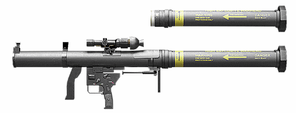 Mk 153 SMAW and munition casing. | |
| Type | Multi-role (anti-fortification, anti-armor) rocket launcher |
| Place of origin | United States |
| Service history | |
| In service | 1984–present |
| Used by | See Operators |
| Wars |
Gulf War War in Afghanistan Iraq War Yemeni Civil War (2015–present)[1][2] Saudi-led intervention in Yemen (2015–present) Conflict in Najran, Jizan and Asir |
| Production history | |
| Designer | McDonnell Douglas |
| Manufacturer | Nammo Talley (formerly Talley Defense Systems) |
| Unit cost | US$13,000 |
| Variants | M141 Bunker Defeat Munition |
| Specifications | |
| Weight |
7.54 kg (16.6 lb) (empty)[3] 13.39 kg (29.5 lb) (loaded)[3] |
| Length |
760 mm (30 in) (unloaded)[3] 1,371 mm (54.0 in) (loaded)[3] |
| Crew | 2 (can be operated by one person, but at lower rate of fire)[3] |
|
| |
| Cartridge weight |
4.5 kg (9.9 lb) (HEAA)[3] 4.2 kg (9.3 lb) (HEDP)[3] |
| Caliber |
83.5 mm (3.29 in) (bore diameter) 83 mm (3.3 in) (rocket diameter) |
| Rate of fire | 3 rounds per minute (practical)[3] |
| Muzzle velocity | 220 m/s (720 ft/s)[3] |
| Effective firing range |
250 m (820 ft) (HEDP)[3] 500 m (1,600 ft) (HEAA)[3] |
| Maximum firing range | 1,800 m (5,900 ft)[3] |
| Feed system | Detachable single-rocket casing |
| Sights |
Iron sights (250 m, 820 ft) Mk 42 Day Sight (3.8× magnification telescopic sight) Night vision sight |
The Mk 153 Shoulder-Launched Multipurpose Assault Weapon (SMAW) is a shoulder-launched rocket weapon with the primary function of being a portable assault weapon (e.g. bunker buster) and a secondary anti-armor rocket launcher. Developed from the B-300, it was introduced to the United States Armed Forces in 1984.[4] It has a maximum range of 500 metres (550 yd) against a tank-sized target.
It can be used to destroy bunkers and other fortifications during assault operations; it can also destroy other designated targets using the dual mode rocket and main battle tanks using the High-Explosive Anti-Armor (HEAA) rocket. Operations in Afghanistan and Iraq saw a thermobaric rocket added (described as a "Novel Explosive" [NE]), which is capable of collapsing a building.[5]
Service history
The SMAW system (launcher, ammunition and logistics support) was fielded in 1984 as a United States Marine Corps–unique system. The Mod 0 demonstrated several shortcomings, resulting in a series of modifications in the mid-2000s. These modifications included a re-sleeving process for bubbled launch tubes, rewriting/drafting operator and technical manuals, and a kit to reduce environmental intrusion into the trigger mechanism. This also includes an optical sight modification to allow the new HEAA rocket to be used effectively against moving armor targets. The U.S. military recently fielded new boresight bracket kits which, when installed, correct the loss of accurate boresight issues between the launch tube and spotting rifle. During Operation Desert Storm, 150 launchers and 5,000 rockets were deployed by the United States Army. Initially the Army showed interest in the system, but ultimately returned the launchers and any unused rockets to the Marine Corps. Later, the U.S. Army developed the SMAW-D ("Disposable"), designated by the Army as the M141 Bunker Defeat Munition.
Follow-On To SMAW
In 2002, the Corps began a program to develop a successor to the SMAW system, tentatively titled "Follow-On To SMAW".[6] The contract was awarded to Lockheed Martin and Israel Military Industries (IMI);[7] this resulted in the enhanced FGM-172 SRAW. In combat operations, it was ultimately used to augment, rather than replace, the SMAW system.
SMAW II program
In 2008, a replacement program was again initiated and titled the SMAW II.[8] It was developed in tandem with a round capable of being fired from an enclosed area without ill effects on the environment and personnel. Its combined weight is 13.5 kilograms (29.7 lb)—5.3 kg (11.7 lb) for the launcher, 8.2 kg (18 lb) for the rocket. The contract was worth up to US$51.7 million, providing the U.S. Marine Corps was satisfied with testing and followed through with plans to buy 1,717 new launchers.[8]
SMAW II Serpent
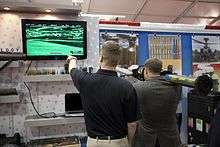
Raytheon Missile Systems is working in coordination with Nammo Talley on the SMAW II project, with Raytheon developing the launcher and Nammo Talley developing the new rounds. The SMAW II launcher is called "Serpent" by the developing companies, and is similar in many respects to the first SMAW launcher, except that it replaces the standard SMAW launcher's spotting gun with sophisticated fire control electronics built by Raytheon. The sighting unit on the launcher is enclosed in a unique roll-cage to protect it. From videos, the roll-cage also serves as a carry handle. The development aims to reduce the over-all weight by four and a half pounds (2.0 kg) from the older SMAW launcher. The Serpent fires the same rounds as the standard SMAW and supports new and improved/enhanced rounds. At the Association of the United States Army (AUSA) 2010 convention, Raytheon stated that it would be ready for deployment by 2012.[9][10]
Design
Compared to the Israel Military Industries' B-300 weapon that it was developed from, the SMAW has slower projectile velocties, it and its ammunition are both heavier, and it takes a second crew member to keep up with the B-300's rate-of-fire, but some of its projectile options have longer ranges than the B-300. The Mk 153 SMAW has an 83.5 millimetres (3.29 in) diameter tube and fires 83-millimetre (3.3 in) rockets. It is a man-portable weapon system consisting of the Mk 153 launcher, the Mk 3 Mod 0 Encased High-Explosive, Dual-Purpose (HEDP) Rocket, the Mk 6 Mod 0 Encased High-Explosive, Anti-Armor (HEAA) Rocket, the Mk 7 Mod 0 Common Encased Practice Rocket, the Mk 80 Mod 0 Encased Novel Explosive (NE) Rocket, and the Mk 217 Mod 0 spotting rifle cartridge.
The launcher consists of the launch tube, spotting rifle, electro-mechanical firing mechanism, mounting brackets, open battle sights and a mount for the Mk 42 Mod 0 Day Sight or AN/PVS-4 or AN/PVS-17B night sights. The launch tube is made of fiberglass-epoxy composite material with a gelcoat on the bore. The spotting rifle is mounted on the right side of the launch tube. It functions semi-automatically by primer actuation, meaning that when fired the primer sets back and unlocks the breech of the spotting rifle, ejecting the spent round. The firing mechanism mechanically fires the spotting rifle, and uses a magnet to fire the rocket. The mounting brackets connect the components and provide the means for boresighting the weapon, while the encased rockets are loaded at the rear of the launcher. The spotting cartridges are stored in a magazine in the cap of the encased rocket.
The 9×51mm Mk 217 spotting round is ballistically matched to the rocket and serves to increase the gunner's first-round hit probability. Each round consists of a special 9 mm projectile which contains a tracer compound, crimped into a 7.62×51mm NATO casing with a .22 Hornet primer.[11] The system can be used in conjunction with the AN/PEQ-2 aiming light in place of the spotting rifle.
As with all of these types of recoilless rocket weapons, the backblast that is created when it is fired is a primary safety concern. When the rocket is fired, the rocket propellant in expended entirely within the rocket encasement. This is the cause of the extremely loud and violent backblast. This backblast extends in a 90-meter, 60° cone to the rear of the weapon. The backblast is lethal out to 30 metres (98 ft), and still extremely dangerous to 90 metres (300 ft). An assistant gunner is often used during employment of the weapon system to monitor the backblast area and clear it of fellow troops, or to notify the gunner of obstructions that could reflect the force of the backblast back at the gun team. The gunner is only cleared to launch a rocket when he hears the command "Backblast area secure" from his assistant gunner. Rounds are under development that would enable a user to fire the rocket from an enclosed building without risk of injury.[12]
The Mk 153 Mod 2 is an enhanced variant, featuring an electronic modular ballistic sight (MBS) in place of the 9 mm spotting system. The MBS has a laser rangefinder and thermal weapon sight to provide a firing solution using a displaced reticle, where crosshairs are adjusted for distance and environmental factors; it is lighter, more reliable, and can be detached from the launcher. While the Mod 0 weighs 7.5 kg (16.5 lb), the Mod 2 weighs 5.9 kg (13 lb) with the MBS attached, and 3.9 kg (8.5 lb) with the MBS detached. Other improvements include increased pad size on the forward grip and foldable backup iron sights.[13] The first 56 Mod 2 systems began deliveries in 2016, with 1,249 to be delivered by October 2020, effectively replacing the existing inventory;[14][15] it began fielding in November 2017.[16]
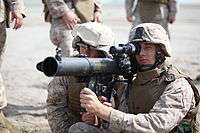 View showing sight
View showing sight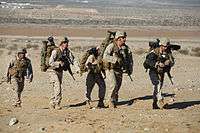 Two SMAW teams
Two SMAW teams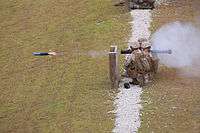 A training round is fired
A training round is fired
Rockets
The Mk 4 Mod 0 Encased High-Explosive, Anti-Armor, Practice Rocket is used in training. The warhead consists of a blue plastic projectile attached to a rocket motor similar to the HEDP rocket. The rocket has no explosive capability against the target except for kinetic energy. Upon impact against a target, the plastic warhead ruptures, dispensing an inert white spotting powder.
The Mk 3 Mod 0 Encased High-Explosive, Dual-Purpose (HEDP) Rocket is effective against bunkers, masonry and concrete walls and light armor. Initiated by a crush switch in its nose, the HEDP rocket is able to distinguish between hard and soft targets resulting in greater penetration into soft targets for increased damage potential. The HEDP round is capable of penetrating 20 centimetres (7.9 in) of concrete, 30 centimetres (12 in) of brick or up to 210 centimetres (6.9 ft) of wood-reinforced sandbags.
The Mk 6 Mod 0 Encased High-Explosive, Anti-Armor (HEAA) Rocket is effective against current tanks without additional armor and utilizes a standoff rod on the detonator, allowing the explosive force to be focused on a small point and for maximum damage against armored targets. The HEAA round is capable of penetrating up to the equivalent of 600 mm of rolled homogeneous steel (RHA).
The Mk 80 Mod 0 Encased Novel Explosive (SMAW-NE) Rocket is effective against caves and bunkers. The SMAW-NE uses a thermobaric warhead, which produces an overpressure wave capable of collapsing a lightly constructed building. The Indian Head Naval Surface Warfare Center teamed with Marine Corps Systems Command and Talley Defense Systems to respond to an urgent U.S. Marine Corps need for a shoulder-launched enhanced-blast warhead in 2003. It was used in combat during both the First and Second offensives in Fallujah, in 2004.
Operators
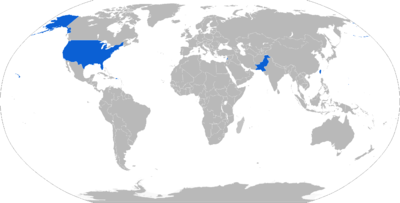
Current operators
See also
References
- ↑ https://www.youtube.com/watch?v=9fZDhPRFhv4
- ↑ https://www.youtube.com/watch?v=PVCt5ou763o
- 1 2 3 4 5 6 7 8 9 10 11 12 "Mk.153 SMAW Anti-Tank Rocket Launcher". Military-Today.com.
- ↑ Staff. "United States Marine Corps Weapons & Equipment Shoulder-Launched Multipurpose Assault Weapon (SMAW)". About.com. Retrieved 8 May 2014.
- ↑ "SMAW Novel Explosive (SMAW-NE)". GlobalSecurity.org.
- ↑ "Follow-On To SMAW (FOTS)". GlobalSecurity.org.
- ↑ "Lockheed Martin to develop Follow-On To Shoulder-Launched Multi-Purpose Assault Weapon for U.S. Marine Corps". Archived from the original on 20 October 2011.
- 1 2 Lamothe, Dan (November 8, 2010). "Redesigned SMAW II set for review". Marine Corps Times. Archived from the original on June 26, 2012. Retrieved 8 November 2010.
- ↑ "DefenseNews video at Association of the US Army 2010 Convention". Defense News.
- ↑ "Accurate and Safe Alternative Targeting Solution for Man Portable Rocket Weapon" (pdf). National Defense Industrial Association.
- ↑ "9 x 51mm SMAW (Shoulder Launched Multipurpose Assault Weapon)". International Ammunition Association.
- ↑ Sanborn, James K. (November 2, 2014). "SMAW upgrade will put rounds on targets faster". Marine Corps Times.
- ↑ "New Modular Ballistic Sight Added to Marine SMAW". Military.com. Defense Video & Imagery Distribution System. 7 August 2013. Retrieved 10 August 2013.
- ↑ Hamby, Barb (November 24, 2015). "Marine Corps awards contract for SMAW Mod 2". Marines.mil. Marine Corps Systems Command.
- ↑ Bacon, Lance M. (December 22, 2015). "Marines will get more lethal, reliable SMAW in 2016". Marine Corps Times.
- ↑ Marines finally field the SMAW Mod 2 - MarineCorpstimes.com, 9 January 2018

External links
| Wikimedia Commons has media related to Shoulder-launched Multipurpose Assault Weapon. |
- SMAW – Global Security
- SMAW at FAS
- SMAW early article
- UNITED STATES MARINE CORPS INTRODUCTION TO CREW SERVED WEAPONS
- U.S. MARINE CORPS TECHNICAL MANUAL OPERATOR’S MANUAL https://www.scribd.com/doc/36175656/TM-08673A-10-1B-83mm-SMAW-Mk